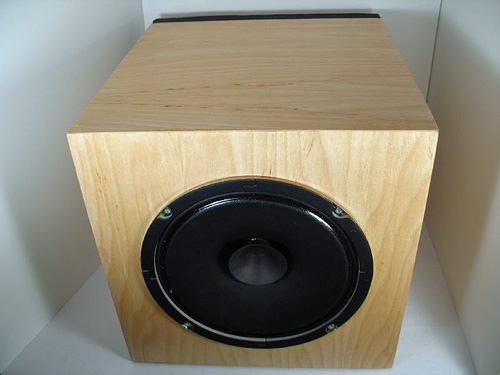Since they’re a more specialty speaker, commercial full-range speakers are hard to find and expensive. Full-range drivers, on the other hand, are widely available and affordable. A lot of audiophiles make their own speakers—and it’s not as hard to do as you might think. The first step is finding a high-quality driver (in this article, we use the 2 terms interchangeably, though if you want to be specific, all of the products below are drivers). The housing you buy or make for the speaker will have a lot to do with which driver you’re working with.
Here are our reviews of the 4 best full range speakers on the market:
Galaxy Audio S5N-8
With a frequency range of 150-18,000Hz, this 5” driver will do full justice to whatever music is played on it, with a smooth, even mid-range. The magnet is made from neodymium, giving it about three times the output to weight ratio over a traditional ceramic magnet, making the speaker more efficient and eliminating distortion. The S5N-8 is video shielded and has a RMS of 100 watts, with a peak handling of 200 watts—all stats that mean it’ll work in most applications and work seamlessly with a broad range of music players. This is one of the best full range driver speakers period.
SB Acoustics SB65WBAC25
For a solid full range speaker driver, check out this SB Acoustics 2.5” product. The furrowed aluminum cone extends the frequency range up to 20,000Hz, and it doesn’t slouch on the low end, either, getting below 100Hz if it’s installed in the right enclosure. Like the Galaxy Audio, the SB65 has a neodymium magnet to get the most possible power, and is video shielded for safe use alongside other electronics. This driver also uses a vented gap cooling system to increase the power handling, and a copper cap on the pole piece to decrease distortion, resulting in a smooth, even tone across the range.
Dayton Audio RS100-4
Drivers in the Dayton Audio Reference series are known for their combination of sound clarity and affordability. The cone is made of rigid aluminum for bright highs and sharp detail. As far as handling, it’s got an RMS of 30 watts and a peak of 60 watts, with a copper voice coil for better performance. The low FS (free-air resonant frequency) gives it a better low-frequency production than many full-range drivers, especially those in the price range. The model linked to here is unshielded and has a 4-ohm impedance, but it’s also available in a shielded 8 ohm version, for those planning to use it alongside televisions or computer monitors. This should be on anyone’s list of the best full range speaker.
DROK 15W mini 3” driver
The DROK 15W is the best driver you can get in this price range. It’s got a good-sized effective frequency, starting at just over 100Hz and going up to 20,000Hk. As a brand, DROK does electronics more than it does speakers, and these are designed from the approach of getting the maximum handling out of a small device. There is some sacrifice in sound quality, especially in the frequency extremes, and does best with solo vocals and acoustic duos. Overall, this is among the best full range speakers if you’re on a budget.
Choosing a Cabinet
Now that you’ve picked your driver, you have to have somewhere to put it. Though this may seem counter-intuitive, speaker cabinets often cost more than the drivers themselves. When you buy a speaker cabinet pre-made, you’re paying for both the quality of the materials and the cost of the workmanship. These Knock-Down brand MDF cabinets are inexpensive and a good functional first cabinet that’ll get a decent baseline sound out of most drivers:
However, you could expect to spend more on a well-made commercial cabinet (see plenty of them here). This might alarm you if you’re on a budget—but don’t get discouraged yet! Making a housing for your speaker is no more difficult than making a box, and if you’re handy, it’s easily doable in an afternoon.
Whether you buy or make your cabinet, the material used in its construction is important to getting the best out of the speaker. Thicker is better; you want to limit the effect of the soundwaves on the cabin and a thicker material—like high grade plywood or MDF—is going to have less flex than something thinner, like fiberboard. If you’re shopping for cabinets, knock on the side to get a sense of how rigid it is—a lower pitched knock indicates a sturdier box. Solid hardwoods are generally going to give you the warmest sound, but you can also make great sounding speakers out of fiberglass.
Open vs. Closed Baffle
The baffle is the front face of a speaker. It’s where the driver is mounted, and also keeps the soundwaves from the front of the speaker from interfering with those coming from the back. Open baffle speakers create a more spacious and immersive sound profile by interacting more with the room. Conventional speakers with a closed baffle will have a tighter sound imaging and less reflection off of the room’s walls and ceiling.
Cabinet Design
The design of your speaker cabinet can be as simple or as complex as you want to make it. Depending on the size of your driver, you want to have an interior volume of 30-45 liters, or 8-12 gallons—about the size of a small fish tank. Smaller speakers are possible but may restrict the sound. Cut one hole for the driver and another either the front or back for a piece of 3” PVC pipe. This will serve as the speaker’s port, allowing air to flow and increasing the response of the bass. Drill a few small holes in the back for the speaker wires, then seal the edges with some caulking or aquarium sealant to make it airtight.
If you’re up for trying something more challenging, the bass horn cabinet design is considered most optimal for increasing low-end frequency response in the best full range drivers. In this version, the space immediately behind the speaker starts small, gradually growing as it snakes through the speaker cabinet until it reaches the port. This cabinet design is also known as a folded horn because the sound’s passage folds in on itself inside the speaker. Speakers using this cabinet are larger and obviously more complex to construct, but can give a fuller sound than more simple box designs.
The great thing about making your own cabinets is it lets you experiment without investing any more money than the cost of the materials. Listening to music on the best full range speakers you crafted by hand, you just may find yourself becoming a budding audiophile.









